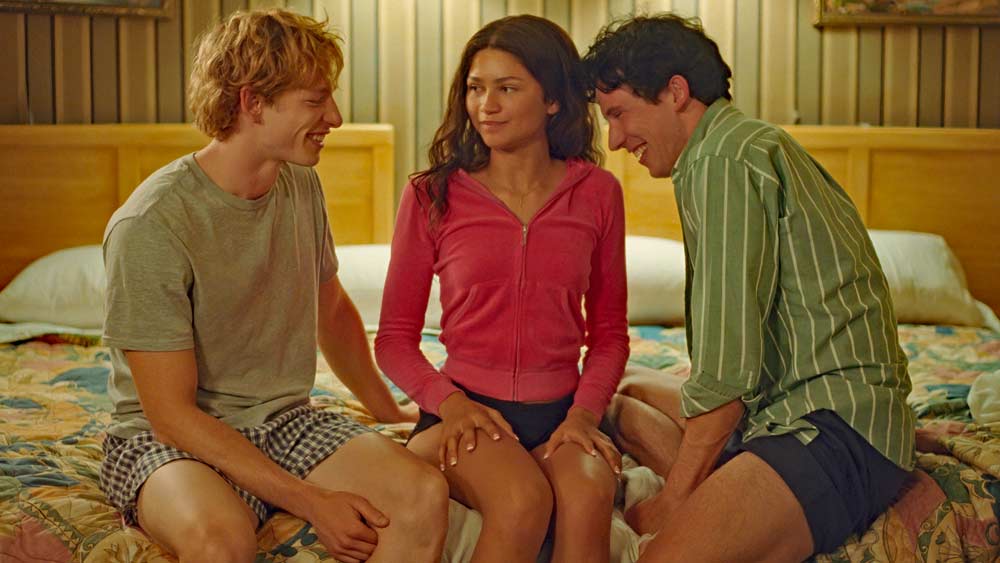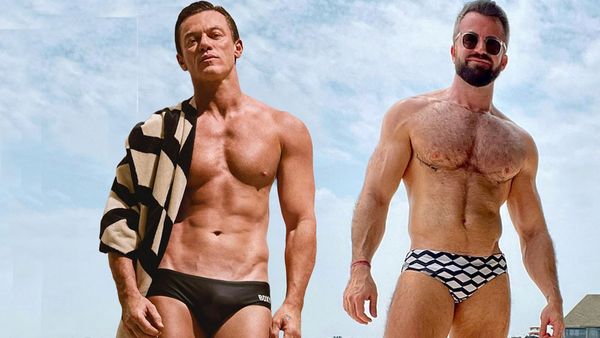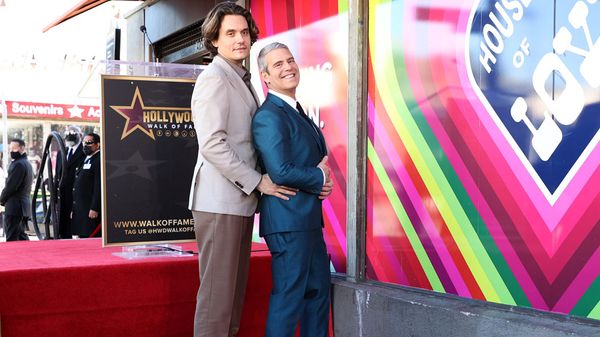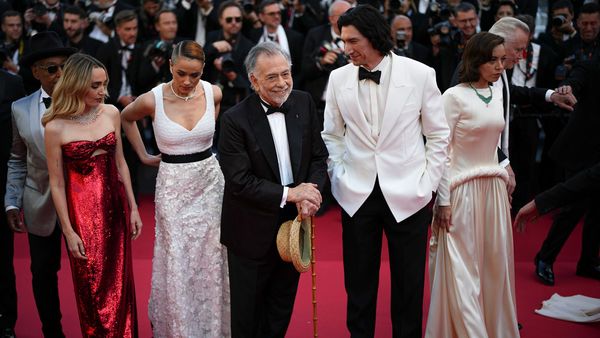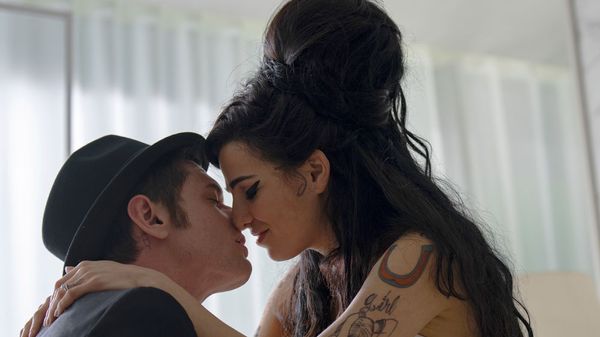December 9, 2016
Reveling in Repertory :: Peter DiMuro and David Parker on Two New Holiday Dance Traditions
Kilian Melloy READ TIME: 18 MIN.
Gesture is as elemental to communication as language -- if not more so; after all, by some accountings, more than 90 percent of communication between human beings is nonverbal, consisting of movement and touch. A glance at Wikipedia offers a different percentage; an article there places nonverbal communication at 75 percent of human communication. The point is, movement and expression count for a lot when people are talking to each other. Art, of course, is a means of having a cultural conversation.
Dance, then, is primal to human beings -- not just in the need to move to the beat, but also when witnessed. Culturally, there may be some ways in which ballet is regarded as the peak of the form, and one of the most reliable classics in the canon of ballet is "The Nutcracker." How could the ballet, with its gorgeous score by Tchaikovsky, and its magical, Christmas Eve-set story, not be a perennial favorite? (Wikipedia claims that ballet companies make 40 percent of their annual incomes from their holiday productions of the show.)
But could there be an alternative? And could such alternatives expand and contemporize the arena of holiday dance programs in which "The Nutcracker" is so monolithically prominent?
Why, in fact, yes. Not only is there an alternative, there's more than one -- and they are set to play in repertory here in Boston this holiday season. Peter DiMuro's "Gumdrops & The Funny Uncle" takes the notion of the holiday family gathering and gives it a GLBT spin; meantime, David Parker's "Nut/Cracked" rejiggers "The Nutcracker" to new and different versions of Tchaikovsky's beloved suite. How much fun is that?
EDGE had a chance to chat with DiMuro and Parker about their shows, their creative history, and the true meaning and purpose of the arts.
EDGE: Your shows are being billed as 'Holiday dance alternatives,' which I think means they are alternatives to 'The Nutcracker,' which sort of owns the holiday season. Why do we need -- or why is it warranted -- to have alternatives?
Peter DiMuro: The inside joke of the dance world is that 'The Nutcracker' is the bread an butter -- all the ballet dancers do their 'Nutcrackers.' After the first year or so of doing it, it becomes, like, the factory of dance. While it's a beautiful form, once you're danced to it over thirteen seasons you get overwhelmed with it all. That's one thing.
For me, at least with our show, the 'alternative' part comes in two ways. One is, yes, it's an alternative to 'The Nutcracker,' but it's also about alternative family. I was with Boston Ballet for one season twenty-something years ago, and I played the Uncle, the magician character, Uncle Drosselmeyer. I'd see all these families that went to the show, and they were all more interested in what was happening in the audience and how pretty everyone looked; it was more about the status symbol of going. I was playing the uncle who has to let go of Clara, his niece, and let her go off into this land of sweets with this soldier, and left the stage after the first act completely emotionally drained.
That built into this whole piece about being the funny, uncle, being the outside, being a gay man in a straight world. It was like, this is only one picture of family. How do we show alternative sides to that? In our production we have ages 20 to 70; we also talk a lot. There are stories of people's experiences from all different corners of the world. We dance to pop music and lighter fare, and then we use the score [of 'The Nutcracker'] as a backdrop to some of the text. It's really an alternative alternative.
David Parker: I've just been talking about this in my class, with my students. Everyone in America knows the music or has been to a [performance of] 'The Nutcracker' or has a kid or a sibling or somebody who dances in it at dancing school, so everybody has a sense of ownership over it.
Boston is a real 'Nutcracker' town -- there are many, many kinds of 'Nutcrackers' in Boston, and having grown up there I went to Boston Ballet 'Nutcracker,' which I loved, often. 'The Nutcracker' is an institution, and like institutions of that sort it reflects its own history. Because it is so traditional in its characterizations and the kinds of dancing that it has, I wanted to make my own version that I felt like I owned, and that inevitably made it 'alternative.' That means the gender roles are much more free, the kinds of dance that it has are much more varied -- there's tap dancing, and jazz, and burlesque, and disco, and modern -- and I wanted to make it to reflect my understanding of Christmas as a set of rituals, some of which are hilarious, some of which are kind of sad, and others of which just need to be updated to include life as it looks now.
EDGE: 'Gumdrops and the Funny Uncle' is described as 'celebrating families of choice through an LGTBQ lens,' and that's what you're describing to me now. Could you say a little more about that?
Peter DiMuro: I've been doing a version of this show for about 15 years. Initially, it was my story -- I like my own story! [Laughter] -- and it was a 20-minute little something. Then, over the years, it started building out; when we traveled to a new town I would hook up with the local gay and lesbian theater group, or sometimes just the community group. In one instance we had a workshop, and there was a woman in her late 60s, a lesbian who had been through some horrific things in the '50s and '60s; and there were some young people who had traveled from Thailand and who were now traveling the world to find family. Different stories started popping up in this workshop, and I said, 'I think we could put all this together inside a new version of "Funny Uncle."' So now it's not only my story, but in a kind of Shakespearean model we have threads from different stories that go throughout the whole piece. Then we end up with this very funky little folk dance.
I always think folk dances are interesting because they are the dances of a people, right? In my Italian world, or in whatever country you're from, you have a little folk dance. My answer to that is to make this alternative family its own folk dance. We have young kids from the school of ballet, they're about 11, 12 years old; and we have people in their 70s in the cast. That's another alternative right there. Usually, in a dance company, it's pretty much 'Get your leg up to this height and do triple turns,' and we do some of that, but we also have a little more dimension.
EDGE: David, how would you describe 'Nut/Cracked?' Is it a riff on 'The Nutcracker?' Or different ways of viewing the work through assorted cultural facets? Or is it a comic reinterpretation?
David Parker: It was not actually my idea to make it, originally. Just by coincidence, in the early 1990s I was making a dance with two men and I had seen in an advertisement on television of a man sucking his thumb -- it was an advertisement for insurance, an adult man sucking his thumb. I thought, 'That is such a striking image.' I started making a dance for two men where they were sucking their own thumbs and using thumb sucking as a way to do ballet partnering. So it was kind of a classical dance thumb sucking duet.
We were rehearsing in my studio, in my loft, at home, and the TV was on and a Christmas commercial came on and it had 'Nutcracker' music, and the dancers were fooling around to it, making the thumb sucking work to the 'Nutcracker' music. I had a Eureka moment -- I thought, 'Oh my god, here it is!' So I made that dance and I used that music. It was only about five minutes long. And we toured that dance in Europe a lot, and it was very popular there, because it was seen as subversive and funny and very different.
One of the producers that saw it in Europe said, 'Why don't you make a whole "Nutcracker" in this same kind of outrageous spirit?' At first I didn't know if I could do that, since I never really thought of myself as someone who would make a version of 'The Nutcracker,' but as I thought about it, my own history of what the holidays mean to me and, actually, my love of 'The Nutcracker,' I decided I could do it if I did it really on my own terms, and that included using music that wasn't the traditional music -- like the Duke Ellington version and other jazz vernacular versions of the music, because that is the kind of dancing that I am very familiar with, it has a lot of rhythmic basis to it, whether it's tap dancing or rhythmic or jazz music, and jazz dancing, and rhythmic forms of modern ballet.
That was my entry point, and I started to make it, really, with the idea of, 'If "The Nutcracker" were my ideal version of it, what would it be like?' So I didn't mean to make fun of it or to re-interpret it; I just decided to take the music at face value and carried through with my own morays and values and ideals. As I did that, I realized that I loved it, and the music is so phenomenal that it can go through all these different kinds of arrangements and still survive. Then I decided that for the second half of my show I would take on the symphonic score, the one that we all know and hear in shopping malls and the radio and everywhere, and try to meet it on my own terms. It felt like it was a big achievement, but I consistently tried to use a sense of rhythm and a sense of humor to enter that music. I think that's why it's been an alternative to these grandiose, massively produced, big ballet versions of it. But it has its own kind of grandeur in its own intimate way. It still only has 15 people in it.
EDGE: How did your shows come to be programmed for repertory presentation at the Boston Center for the Arts?
Peter DiMuro: My company, Public Displays of Motion, is a resident artist there, and I've known David for thirty years -- David and Jeff, who are co-artistic directors for the main group. I've been in their shows, and I'm, in their show this year as well. When I was thinking about doing this I reached out and said, 'You know it would be fun to do this in repertory. We have these two alternatives happening.' So we're sharing Friday, Saturday, and Sunday, we each have a show on each of those days; and then we're Wednesday and they're Thursday of that week.
I love what David does. His work is just so innovative and new.
David Parker: This idea came to us last year. Peter is a good friend of mine, and years ago we made a touring company with his work, my work, and another colleague of ours named Mary, and toured, and we called it The Company We Keep. We stayed friends all through various adventures. When he came back to Boston, I'd already been doing a lot of work in Boston, even though I'm more based in New York. I asked him if he'd be a guest artist in my 'Nut/Cracked' last year. So he did a cameo in 'Nut/Cracked' last year, and then he came back to me this year and said, 'How about we do these shows in repertory?' And I remembered that ten years ago in New York, we had played part of his show 'Funny Uncle,' also in repertory with 'Nut/Cracked,' and they feel very complementary because they're both really irreverent and funny -- but also, I think, quite serious about what Christmas means to people as a kind of national ritual. I think that 'The Nutcracker' and all these sort of performance elements that happen during Christmas are part of it. There aren't that many things that happen in America, national ways of [finding commonality], that take place through performance. This is one of the only ones. We wanted to highlight that.
EDGE: How well do the two shows mesh? Will audiences who see both sense shared themes or other commonalities?
Peter DiMuro: I think they complement each other. It's funny: Thirty years ago when David and I first shared shows throughout New England, through many, many benefits for Community Servings, which was a pet project of David's mother, we always said - and I feel that is true of this show - that our work was dissimilar but complementary. I often use text in my work and we're chatting, and it kind of goes from a very pedestrian gestural world to a full-blown dance. It's not necessarily character-driven, but persona-driven: We're real people who happen to be dancers. I think that is a commonality -- David and his crew are truly people who are very skilled dancers and skilled at everything from tap to modern and beyond. I can't tap to save my life, and I think where David thinks of emotionality and rhythm, and brings people to a sense of wonder and amazement with rhythm and bubble wrap and those sorts of things, I do it more with the storytelling itself that combines with movement. Gosh, we should do this more often!
[Laughter]
I think that folks feel like they don't know dance, but I think they do. The portal experience for someone, in my work at least, when they come to see it, often people say, "I didn't understand what you were doing or moving about until you said that three-sentence line at the end of it." I feel there's an accessibility quotient; I don't want people to walk away feeling mystified. I want to have a window into what we are thinking about so they can sit back and enjoy the work. I'll let David talk for himself, but I feel like tap and they rhythm, and people feel when they hear tap and percussive dance, it does the same thing. You don't worry so much about the message: It comes across after the whole experience is over.
David Parker: I think there's definitely a very free-wheeling approach to gender and social morays, and a broad idea of how many different kinds of bands can be put into the same evening. I think we're very sympathetic just in our views of how people are with each other, and how much fun that can be, and how open and diverse that can be. But Peter's show is an original show that he created from scratch, and mine is a version of "The Nutcracker," so mine does connect to that other element.
EDGE: You mentioned your company, Peter, Public Displays of Motion - I think that's a nice riff on similar sounding phrases like "Public display of emotion," or "Public displays of affection." I think that speaks to the core of dance, how movement and feeling are so bound up together. Why do motion and emotion have such a primal correlation?
Peter DiMuro: Thanks for picking that up! One the reasons the phrase came about is the three capital letters of my name -- P, D, M -- comes out to "Public Displays of Motion" for me. I was trying to find a title for the company that would not include the word "dance" but still get that idea across. I worked for many years with a woman named Liz Lehrman at a company called Dance Exchange; like my current company it was intergenerational, ages 20 through 50-something in the core company; we have a little wider range now, just for this show.
It's important to me that movement is an entitlement for everybody and not just trained dancers. And if people come to training -- not to say that it's not rigorous it's not choreographed and it's not pleasing to the eye -- but who's to say that a gesture made by a 68-year-old woman as she wipes her brow isn't poetic, or isn't worthy to be called dance? For me, it's about interrupting society's notion of dance.
Often, dance can be very emotional, and it can be... we joke about this, we have a section of the piece that we call "the telenovela section," and it's intentionally over the top: Lots of emotion, and lots of pulling hair in a very old fashioned modern dance kind of way. This connection between motion and emotion... people see motion, and they respond viscerally, because they move themselves, they know this gesture, and they feel they know it. Sometimes I try to take a lot of the overt emotion out of the performances because I want the audience to come forward with their own emotions. Often it's like when your talking to someone that's over the top with lots of crying: There's no room for your emotion in that space. That's what I try to provide, and what dance does, it takes the emotion in the space. It's like moving sculpture. It evokes you to bring your emotion to it. That's what we hope we're doing.
EDGE: David, your work is described as proceeding from 'an abiding love of rhythmic form and the intensity of communication it allows between audiences and performers.' How does that intensity of communication happen through dance? Or, phrasing it the same way as I put the question to Peter: Why do motion and emotion have such a primal correlation?
David Parker: I believe very strongly that the ting that binds them is rhythm, is time. We're always operating rhythmically -- that's how we coordinate things from thought to complicated movement. You just do things automatically -- like writing, or speaking, we don't think about how we do it any longer; rhythm is the force in our brains that coordinates those things and makes them possible. That's also true with emotion. Because we respond to rhythm in a kind of pre-conscious way, it puts us in touch, automatically, with our emotional states, because it's a short-circuit analysis; you can analyze it later, but in the moment of response I think it comes to something very basic. I think that for people, emotion and motion being combined by rhythm is what they find to be so powerful.
EDGE: Peter, since you're an openly gay artist, I wonder whether that wellspring of experience allows you a different kind of creative access, or insight, or interpretive focus?
Peter DiMuro: Oh, that's interesting... There are dances that are just about illuminating music, right? And then there are dances that are about things. When I felt that I changed the way I made dances, when I made my first AIDS-inspired work -- this was probably 1990 -- because I was so passionately connected to the subject matter, this dance had to talk out loud. I didn't want anybody to mistake this dance for anything else but a piece about communicating with those who were dying. To me, that unleashed a sense of structure and a sense of commitment to an idea.
In our post-modern dance world a lot of it is about concept. I found myself, for the first time, working with post-modern concepts, but a very emotional subject matter that I wouldn't have gotten to, I don't think, if I had not been a gay man losing all his friends at the time. Over the years I feel like I've channeled whatever it is that makes me, me; and that appears in the work; that's true, I think for any good artist who has a voice. A lot of my partnering is same-sex partnering, and not that it means that it's two lesbians or two gay men dancing together; I just say, 'Why the hell does it have to be a man and a woman?' I find that so boring when I go see anything. 'Wait a second, I know she's really strong. Why are we reinforcing this "princess" stereotype?' If I have any agenda, it's that we're all human. After that, it's free reign. We can and should do whatever we want on the dance floor and in the dance studio or in the theater, etc.
EDGE: David, athleticism and eros are bound up in physically expressive art forms like dance. But dance also has a sort of metaphysical aura about it, something that transcends the physical.
David Parker: I think just the idea that people come on stage and they're going to give you themselves through movement is both emotional and erotic. Dance is one of the only times... athletics in itself can be very expressive and very moving, but their goal is to win. Whereas, with dance, the goal really is to express. There's no winner or loser. A tennis player can have beautiful form and miss the ball, and it doesn't matter; but the form of dance is its own subject, and its own reward. It is what it expresses.
EDGE: David, 'Nut/Cracked' has been around for quite a while -- at least ten years.
David Parker This is our fourteenth season.
EDGE Does the show get teaks and updates as time passes? Or it is in pretty much the same form now as when it first premiered?
David Parker: For the first ten years I did tweak it. Its first season, in 2003, it had only five people, and it was shorter. And now it has 15 people, and it's 55 minutes. So I've gradually built it up over its first ten years. But since then, for the last four years, it's like a Broadway show -- it's always in the same form; I don't have to direct rehearsals any more, I let somebody else do that, and then I come in at the end, because it's such an independent entity now.
EDGE: The arts have really been a force in helping minorities of all sorts make great gains in acceptance and equality. Suddenly, though, there is a widespread sense that we are on the verge of seeing our progress and hard-earned rights snatched away. How can the arts help protect the gains we've made?
Peter DiMuro: I know for me, after the election I had a few days of numbness. And then I went back into rehearsal for 'Gumdrops,' and there I am, working... [Chokes up] Sorry, I'm getting a little emotional... There I am, working with this cast of allies and LGBTQ people... even though the subject matter is treated, like 'The Nutcracker,' it's not a presentation of the deepest self, but the people involved are deep. And that is an agenda of mine: I want 'normal' families to come and see our normal families. That in itself is a political statement. All the arts do this, but dance especially: Dance used wisely and well can be a reconciliatory tool. You can find your way through the images you see on stage. All the arts can filter and shade them, with spoken word being the most overtly political, but also slightly subversive as well. I think it is important right now, and I feel a sense of recommitment after this election. When I see the hate that's happening around us, I have to counter that with two bodies touching in a way that's supportive. For each time that anyone strikes out against a black person or a Muslim person or a gay person, we have to counter that.
David Parker: I think that's absolutely true, and I think all of us are seeing our work though that lens now -- it represents that history of open mindedness and diversity, and we need to state that very clearly going forward.
"Gumdrops/The Funny Uncle" and "Nut/Cracked" play in repertory at the Boston Center for the Arts from Dec. 14 - 18. For tickets and more information, please go to http://www.bcaonline.org/calendar/calendar-of-events/details/864-gumdrops-and-the-funny-uncle.html (for "Gumdrops & The Funny Uncle") and http://www.bcaonline.org/calendar/calendar-of-events/details/865-nut-cracked.html (for "Nut/Cracked")
Kilian Melloy serves as EDGE Media Network's Associate Arts Editor and Staff Contributor. His professional memberships include the National Lesbian & Gay Journalists Association, the Boston Online Film Critics Association, The Gay and Lesbian Entertainment Critics Association, and the Boston Theater Critics Association's Elliot Norton Awards Committee.

